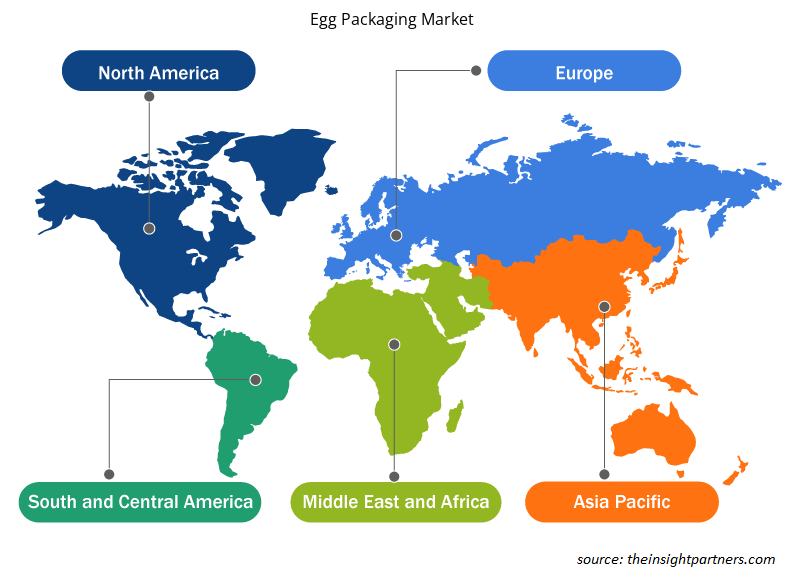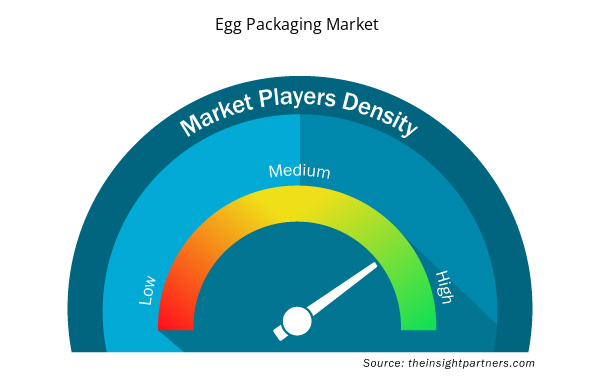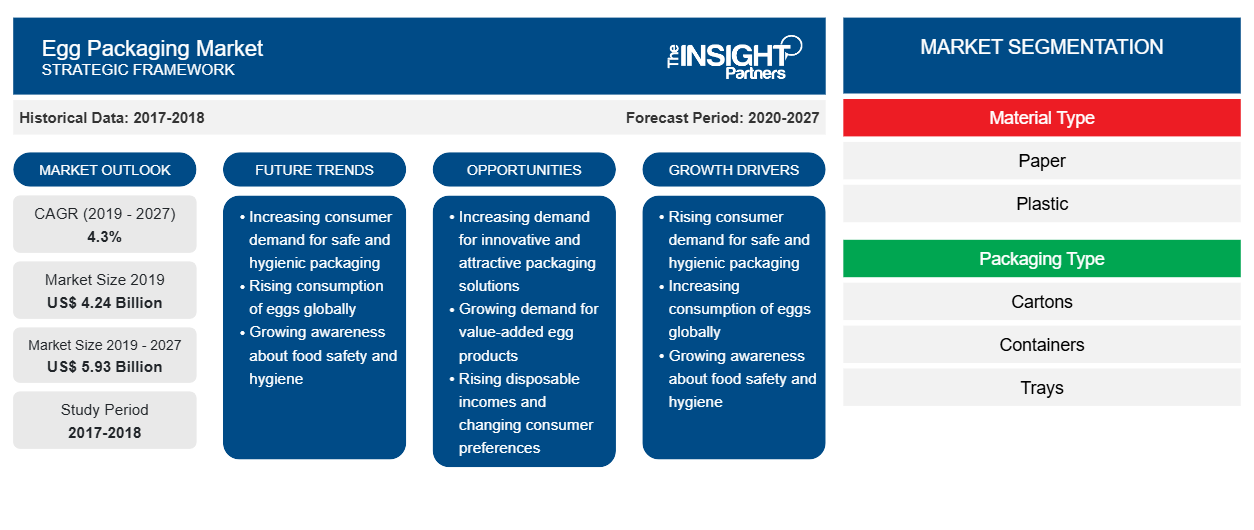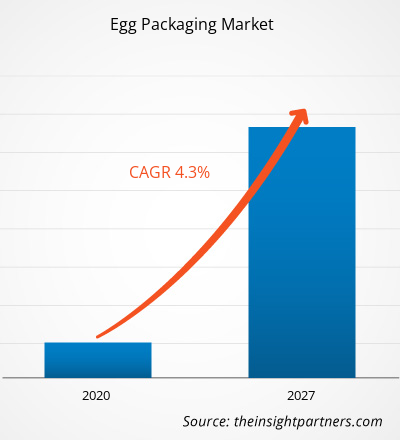Der Markt für Eierverpackungen hatte im Jahr 2019 einen Wert von 4.243,42 Millionen US-Dollar und soll bis 2027 einen Wert von 5.932,01 Millionen US-Dollar erreichen; von 2020 bis 2027 wird mit einer durchschnittlichen jährlichen Wachstumsrate von 4,3 % gerechnet.
Eierverpackungen sind Verpackungsmaterialien, die speziell für die sichere Lagerung und den Transport von Eiern entwickelt wurden. Die empfindliche und poröse Beschaffenheit von Eierschalen erfordert eine robuste und sichere Verpackungslösung. Kartons, Schalen, Körbe und Behälter sind einige der am häufigsten verwendeten Eierverpackungslösungen. Sie werden aus Karton, Recyclingpapier, Polyethylenterephthalat oder Polystyrol hergestellt. Diese Materialien sind praktisch und helfen auch dabei, die Belastungen oder Stöße abzufedern, die beim Umgang mit den Eiern oder beim Transport auftreten. Darüber hinaus schützt die Eierverpackung die Eier vor Bakterien, Verunreinigungen, natürlichen Feinden und Feuchtigkeitsverlust. All diese Vorteile haben die Nachfrage nach Eierverpackungen erhöht.
Im Jahr 2019 hatte Europa einen bedeutenden Anteil am Eierverpackungsmarkt . Allerdings wird erwartet, dass der asiatisch-pazifische Raum im Prognosezeitraum die am schnellsten wachsende Region sein wird. Das Wachstum des Eierverpackungsmarktes in Europa ist in erster Linie auf den steigenden Eierkonsum und die steigende Nachfrage aus der Gastronomie und Lebensmittelverarbeitungsindustrie zurückzuführen.
Der COVID-19-Ausbruch wurde erstmals im Dezember 2019 in Wuhan (China) gemeldet. Seit Februar 2021 gehören die USA, Brasilien, Indien, Russland, Spanien und das Vereinigte Königreich zu den am stärksten betroffenen Ländern in Bezug auf bestätigte Fälle und gemeldete Todesfälle. Der Ausbruch wirkt sich aufgrund von Lockdowns, Reiseverboten und Geschäftsschließungen negativ auf die Wirtschaft und Industrie in verschiedenen Ländern aus. Die Lebensmittel- und Getränkeindustrie ist eine der weltweit wichtigsten Branchen, die unter schwerwiegenden Störungen wie Unterbrechungen der Lieferkette, Absagen von Technologieveranstaltungen und Büroschließungen leidet. China beispielsweise ist das globale Produktionszentrum und der größte Rohstofflieferant für verschiedene Branchen und gehört zu den am schlimmsten betroffenen Ländern. Die Schließung verschiedener Werke und Fabriken in China hat die globalen Lieferketten eingeschränkt und die Produktionsaktivitäten, Lieferpläne und den Verkauf verschiedener Produkte gestört. Verschiedene Unternehmen haben bereits mögliche Verzögerungen bei Produktlieferungen und einen Einbruch des zukünftigen Verkaufs ihrer Produkte angekündigt. Darüber hinaus behindern die von Ländern in Europa, Asien und Nordamerika verhängten globalen Reiseverbote die Möglichkeiten für Geschäftskooperationen und Partnerschaften. Alle diese Faktoren beeinträchtigen die Lebensmittel- und Getränkeindustrie und wirken somit als Bremsfaktoren für das Wachstum verschiedener mit dieser Industrie verbundener Märkte.
Passen Sie diesen Bericht Ihren Anforderungen an
Sie erhalten kostenlose Anpassungen an jedem Bericht, einschließlich Teilen dieses Berichts oder einer Analyse auf Länderebene, eines Excel-Datenpakets sowie tolle Angebote und Rabatte für Start-ups und Universitäten.
- Holen Sie sich die wichtigsten Markttrends aus diesem Bericht.Dieses KOSTENLOSE Beispiel umfasst eine Datenanalyse von Markttrends bis hin zu Schätzungen und Prognosen.
Markteinblicke
Bequemer Eiertransport wird immer beliebter
Die Eierverpackung ist ein wesentlicher Bestandteil, um den Verbrauchern hochwertige Eier anzubieten. Sie schützt die Eier vor Bakterien, Verunreinigungen, natürlichen Feinden und Feuchtigkeitsverlust. Außerdem schützt die Eierverpackung vor möglichem Zerdrücken während der Handhabung, Lagerung oder des Transports der Eier. Im Vergleich zu jedem anderen Schritt während der Verarbeitung und Verteilung gehen beim Transport viele Eier kaputt. Daher entsteht durch zerbrochene Eier ein wirtschaftlicher Schaden, da das Auftreten von Rissen das Risiko einer bakteriellen Kontamination der zerbrochenen Eier erhöht, was die Qualität mindert und Probleme hinsichtlich der Lebensmittelsicherheit verursacht. Daher werden zum Verpacken der Eier hauptsächlich Eierverpackungen in Form von Schalen, Kartons oder Kartons verwendet. Die Kartons bieten den Eiern den besten mechanischen Schutz. Die Kartons haben eine Noppenform und die Struktur schützt die Eier vor Belastungen und Stößen, die während der Lagerung und des Transports auftreten, und verringert so die mögliche Beschädigung oder das Zerdrücken der Eierschalen. Daher führen die Hersteller Eierkartons in verschiedenen Formen und Größen ein, um die Lagerung und den Transport der Eier zu erleichtern. Daher treibt die zunehmende Vorliebe für Eierverpackungsprodukte in Form von Schalen, Kartons oder Kartons für den Eiertransport das Wachstum auf dem Eierverpackungsmarkt voran.
Einblicke in Materialtypen
Basierend auf der Materialart ist der Eierverpackungsmarkt in Papier, Kunststoff und andere unterteilt. Das Papiersegment führte den Markt mit dem höchsten Marktanteil im Jahr 2019 an. Verpackungen auf Papierbasis schützen Waren und reduzieren Abfall, außerdem sind sie recycelbar. Das verantwortungsvolle Recycling von Altpapier und Verpackungen reduziert Abfall und Mülldeponien. Es verhindert Abfall durch Bruch, Verderb und Verunreinigung und verlängert die Haltbarkeit des Produkts. Verpackungen auf Papierbasis sind eine vielseitige und kostengünstige Methode zum Transportieren, Schützen und Konservieren einer breiten Palette von Artikeln. Sie sind robust und dennoch leicht konstruiert und können an produkt- oder kundenspezifische Anforderungen angepasst werden. Verpackungen auf Papierbasis werden aus Papierzellstoff hergestellt. Ihr Design hat sich seitdem nicht wesentlich verändert. Sie wurden eine Zeit lang durch PET-Verpackungen ersetzt, aber die Öffentlichkeit bevorzugte das natürliche Aussehen und die Haptik des Kartons aus Papierzellstoff. Eierkartons aus Papier sind biologisch abbaubar und werden von fast allen lokalen Recyclingagenturen akzeptiert. All diese Faktoren treiben das Wachstum des Eierverpackungsmarktes im Papiersegment voran.
Einige wichtige Marktteilnehmer sind Sonoco Products Company; Placon; Mauser Corporate GMBH; JIN FU HUA PACKAGING INDUSTRIAL CO., LTD.(JFH); Huhtamaki Oyj; CKF Inc.; Cascades Inc; Brodrene Hartmann AS; Reynolds Group Holdings Limited.; und Cellulose de la Loire. Wichtige Akteure auf dem Eierverpackungsmarkt konzentrieren sich auf Strategien wie Fusionen und Übernahmen sowie Produkteinführungen, um ihre geografische Präsenz und Kundenbasis weltweit zu vergrößern. Sonoco Products Company; Placon; Mauser Corporate GMBH; JIN FU HUA PACKAGING INDUSTRIAL CO., LTD.(JFH); Huhtamaki Oyj; CKF Inc.; Cascades Inc; Brodrene Hartmann AS; Reynolds Group Holdings Limited.; and Cellulose de la Loire. Major players operating in the egg packaging market are focused on strategies such as mergers and acquisitions, and product launches to increase their geographical presence and consumer base globally.
Regionale Einblicke in den Eierverpackungsmarkt
Die regionalen Trends und Faktoren, die den Eierverpackungsmarkt im Prognosezeitraum beeinflussen, wurden von den Analysten von Insight Partners ausführlich erläutert. In diesem Abschnitt werden auch die Marktsegmente und die Geografie des Eierverpackungsmarktes in Nordamerika, Europa, im asiatisch-pazifischen Raum, im Nahen Osten und Afrika sowie in Süd- und Mittelamerika erörtert.

- Erhalten Sie regionale Daten zum Eierverpackungsmarkt
Umfang des Eierverpackungsmarktberichts
| Berichtsattribut | Details |
|---|---|
| Marktgröße im Jahr 2019 | 4,24 Milliarden US-Dollar |
| Marktgröße bis 2027 | 5,93 Milliarden US-Dollar |
| Globale CAGR (2019 - 2027) | 4,3 % |
| Historische Daten | 2017-2018 |
| Prognosezeitraum | 2020–2027 |
| Abgedeckte Segmente | Nach Materialtyp
|
| Abgedeckte Regionen und Länder | Nordamerika
|
| Marktführer und wichtige Unternehmensprofile |
|
Dichte der Marktteilnehmer für Eierverpackungen: Die Auswirkungen auf die Geschäftsdynamik verstehen
Der Markt für Eierverpackungen wächst rasant, angetrieben durch die steigende Nachfrage der Endverbraucher aufgrund von Faktoren wie sich entwickelnden Verbraucherpräferenzen, technologischen Fortschritten und einem größeren Bewusstsein für die Vorteile des Produkts. Mit steigender Nachfrage erweitern Unternehmen ihr Angebot, entwickeln Innovationen, um die Bedürfnisse der Verbraucher zu erfüllen, und nutzen neue Trends, was das Marktwachstum weiter ankurbelt.
Die Marktteilnehmerdichte bezieht sich auf die Verteilung der Firmen oder Unternehmen, die in einem bestimmten Markt oder einer bestimmten Branche tätig sind. Sie gibt an, wie viele Wettbewerber (Marktteilnehmer) in einem bestimmten Marktraum im Verhältnis zu seiner Größe oder seinem gesamten Marktwert präsent sind.
Die wichtigsten auf dem Eierverpackungsmarkt tätigen Unternehmen sind:
- Sonoco Products Company
- Placon
- Mauser Corporate GMBH
- JIN FU HUA PACKAGING INDUSTRIAL CO., LTD. (JFH)
- Huhtamaki Oyj
Haftungsausschluss : Die oben aufgeführten Unternehmen sind nicht in einer bestimmten Reihenfolge aufgeführt.

- Überblick über die wichtigsten Akteure auf dem Eierverpackungsmarkt
Bericht-Spotlights
- Fortschrittliche Branchentrends auf dem globalen Eierverpackungsmarkt helfen den Akteuren bei der Entwicklung wirksamer langfristiger Strategien
- In Industrie- und Entwicklungsländern angewandte Strategien für Unternehmenswachstum
- Quantitative Analyse des globalen Eierverpackungsmarktes von 2017 bis 2027
- Schätzung der Nachfrage nach Eierverpackungen in verschiedenen Branchen
- PEST-Analyse zur Veranschaulichung der Wirksamkeit der in der Branche tätigen Käufer und Lieferanten bei der Vorhersage des Marktwachstums
- Aktuelle Entwicklungen zum Verständnis der Wettbewerbssituation auf dem Markt und der Nachfrage nach Eierverpackungen
- Markttrends und -aussichten in Verbindung mit Faktoren, die das Wachstum des Eierverpackungsmarktes vorantreiben und bremsen
- Entscheidungsprozess durch das Verständnis von Strategien, die das kommerzielle Interesse im Hinblick auf das Wachstum des globalen Eierverpackungsmarktes untermauern
- Größe des Eierverpackungsmarktes an verschiedenen Marktknoten
- Detaillierte Übersicht und Segmentierung des globalen Eierverpackungsmarktes sowie seiner Dynamik in der Branche
- Marktgröße für Eierverpackungen in verschiedenen Regionen mit vielversprechenden Wachstumschancen
Eierverpackungsmarkt nach Materialtyp
- Papier
- Karton
- Recyclingpapier
- Sonstiges
- Plastik
- Polyethylenterephthalat
- Polystyrol
- Sonstiges
- Sonstiges
Eierverpackungsmarkt, nach Verpackungstyp
- Kartons
- Behälter
- Tabletts
- Sonstiges
Firmenprofile
- Sonoco Products Company
- Placon
- Mauser Corporate GMBH
- JIN FU HUA PACKAGING INDUSTRIAL CO., LTD. (JFH)
- Huhtamaki Oyj
- CKF Inc.
- Cascades Inc
- Brodrene Hartmann AS
- Reynolds Group Holdings Limited.
- Zellulose aus der Loire
- Historische Analyse (2 Jahre), Basisjahr, Prognose (7 Jahre) mit CAGR
- PEST- und SWOT-Analyse
- Marktgröße Wert/Volumen – Global, Regional, Land
- Branche und Wettbewerbsumfeld
- Excel-Datensatz



Report Coverage
Revenue forecast, Company Analysis, Industry landscape, Growth factors, and Trends

Segment Covered
This text is related
to segments covered.

Regional Scope
North America, Europe, Asia Pacific, Middle East & Africa, South & Central America

Country Scope
This text is related
to country scope.
Häufig gestellte Fragen
Paper-based packaging protects goods, reduces waste and is recyclable. Packaging reduces waste. Recycling waste paper and packaging responsibly reduces litter and landfill. It prevents waste through breakage, spoilage and contamination, and extends product shelf life. Paper-based packaging is a versatile and cost-efficient method to transport, protect and preserve a wide array of items. It is engineered to be sturdy, yet lightweight, and is customizable to meet product- or customer-specific needs. It is made from paper pulp Its design has not changed much since then. It was replaced for a while with PET packaging but the public preferred the natural look and feel of the paper pulp carton. Paper egg cartons are biodegradable and accepted by almost all local recycling agencies. This further propels the growth of the paper segment in the global egg packaging market.
The major players operating in the global egg packaging market are Sonoco Products Company., Placon, MAUSER Group, Jin Fu Hua Packaging Industrial Co.,Ltd, Huhtamaki Oyj, CKF Inc., Cascades Inc., Hartmann, Reynolds Group Holdings Limited, Cellulose de la Loire and among others.
In 2019, the egg packaging market was dominated by Rest of World region at the global level. Rest of the world comprises several developing regions such as Asia- Packaging, Middle- East and Africa, and South America. The high rate of poultry farming and increasing consumption of egg-based foods supports the demand for egg packaging in the rest of the world. Advancements in food processing industries leading to the launch of egg-based products also support market growth. Moreover, growing awareness about the health benefits along with high protein content favors the eggs, which is further propelling the demand of egg packaging in the rest of the world.
Trends and growth analysis reports related to Chemicals and Materials : READ MORE..
The List of Companies - Egg Packaging Market
- Sonoco Products Company
- Placon
- Mauser Corporate GMBH
- JIN FU HUA PACKAGING INDUSTRIAL CO.,LTD.(JFH)
- Huhtamaki Oyj
- CKF Inc.
- Cascades Inc
- Brodrene Hartmann AS
- Reynolds Group Holdings Limited.
- Cellulose de la Loire
The Insight Partners performs research in 4 major stages: Data Collection & Secondary Research, Primary Research, Data Analysis and Data Triangulation & Final Review.
- Data Collection and Secondary Research:
As a market research and consulting firm operating from a decade, we have published and advised several client across the globe. First step for any study will start with an assessment of currently available data and insights from existing reports. Further, historical and current market information is collected from Investor Presentations, Annual Reports, SEC Filings, etc., and other information related to company’s performance and market positioning are gathered from Paid Databases (Factiva, Hoovers, and Reuters) and various other publications available in public domain.
Several associations trade associates, technical forums, institutes, societies and organization are accessed to gain technical as well as market related insights through their publications such as research papers, blogs and press releases related to the studies are referred to get cues about the market. Further, white papers, journals, magazines, and other news articles published in last 3 years are scrutinized and analyzed to understand the current market trends.
- Primary Research:
The primarily interview analysis comprise of data obtained from industry participants interview and answers to survey questions gathered by in-house primary team.
For primary research, interviews are conducted with industry experts/CEOs/Marketing Managers/VPs/Subject Matter Experts from both demand and supply side to get a 360-degree view of the market. The primary team conducts several interviews based on the complexity of the markets to understand the various market trends and dynamics which makes research more credible and precise.
A typical research interview fulfils the following functions:
- Provides first-hand information on the market size, market trends, growth trends, competitive landscape, and outlook
- Validates and strengthens in-house secondary research findings
- Develops the analysis team’s expertise and market understanding
Primary research involves email interactions and telephone interviews for each market, category, segment, and sub-segment across geographies. The participants who typically take part in such a process include, but are not limited to:
- Industry participants: VPs, business development managers, market intelligence managers and national sales managers
- Outside experts: Valuation experts, research analysts and key opinion leaders specializing in the electronics and semiconductor industry.
Below is the breakup of our primary respondents by company, designation, and region:

Once we receive the confirmation from primary research sources or primary respondents, we finalize the base year market estimation and forecast the data as per the macroeconomic and microeconomic factors assessed during data collection.
- Data Analysis:
Once data is validated through both secondary as well as primary respondents, we finalize the market estimations by hypothesis formulation and factor analysis at regional and country level.
- Macro-Economic Factor Analysis:
We analyse macroeconomic indicators such the gross domestic product (GDP), increase in the demand for goods and services across industries, technological advancement, regional economic growth, governmental policies, the influence of COVID-19, PEST analysis, and other aspects. This analysis aids in setting benchmarks for various nations/regions and approximating market splits. Additionally, the general trend of the aforementioned components aid in determining the market's development possibilities.
- Country Level Data:
Various factors that are especially aligned to the country are taken into account to determine the market size for a certain area and country, including the presence of vendors, such as headquarters and offices, the country's GDP, demand patterns, and industry growth. To comprehend the market dynamics for the nation, a number of growth variables, inhibitors, application areas, and current market trends are researched. The aforementioned elements aid in determining the country's overall market's growth potential.
- Company Profile:
The “Table of Contents” is formulated by listing and analyzing more than 25 - 30 companies operating in the market ecosystem across geographies. However, we profile only 10 companies as a standard practice in our syndicate reports. These 10 companies comprise leading, emerging, and regional players. Nonetheless, our analysis is not restricted to the 10 listed companies, we also analyze other companies present in the market to develop a holistic view and understand the prevailing trends. The “Company Profiles” section in the report covers key facts, business description, products & services, financial information, SWOT analysis, and key developments. The financial information presented is extracted from the annual reports and official documents of the publicly listed companies. Upon collecting the information for the sections of respective companies, we verify them via various primary sources and then compile the data in respective company profiles. The company level information helps us in deriving the base number as well as in forecasting the market size.
- Developing Base Number:
Aggregation of sales statistics (2020-2022) and macro-economic factor, and other secondary and primary research insights are utilized to arrive at base number and related market shares for 2022. The data gaps are identified in this step and relevant market data is analyzed, collected from paid primary interviews or databases. On finalizing the base year market size, forecasts are developed on the basis of macro-economic, industry and market growth factors and company level analysis.
- Data Triangulation and Final Review:
The market findings and base year market size calculations are validated from supply as well as demand side. Demand side validations are based on macro-economic factor analysis and benchmarks for respective regions and countries. In case of supply side validations, revenues of major companies are estimated (in case not available) based on industry benchmark, approximate number of employees, product portfolio, and primary interviews revenues are gathered. Further revenue from target product/service segment is assessed to avoid overshooting of market statistics. In case of heavy deviations between supply and demand side values, all thes steps are repeated to achieve synchronization.
We follow an iterative model, wherein we share our research findings with Subject Matter Experts (SME’s) and Key Opinion Leaders (KOLs) until consensus view of the market is not formulated – this model negates any drastic deviation in the opinions of experts. Only validated and universally acceptable research findings are quoted in our reports.
We have important check points that we use to validate our research findings – which we call – data triangulation, where we validate the information, we generate from secondary sources with primary interviews and then we re-validate with our internal data bases and Subject matter experts. This comprehensive model enables us to deliver high quality, reliable data in shortest possible time.


 Holen Sie sich ein kostenloses Muster für diesen Bericht
Holen Sie sich ein kostenloses Muster für diesen Bericht